Everybody is bitten by the travel bug these days if the #wanderlust or #fernweh mean something to you, then I’m sure you’re always on the lookout to go to new places where you can take candid pictures and post them on your Instagram.
Travelling can bring a lot of peace and an opportunity to experience new culture. But, travelling to Buddhist monasteries has its own perks. You experience peace and serenity like never before.
So, whether you are digital nomad or somebody who likes to get out and travel very often then these 18 Buddhist monasteries are a must visit!
P.S. – There’s no particular order to this list. You can pick any place on this list, pack your bags and go.
1. Ghoom Monastery, Darjeeling, West Bengal

At a glance –
- Main Attraction: 15 feet statue of Maitreya Buddha
- Built in: 1850
- How to get there: It’s about 8 km from the Darjeeling town. A half an hour ride from the town by car and 10-12 minutes walk from the Ghoom station.
- Open: All days in the week, morning to evening
- Note: You may have to pay to take photos and videos inside.
Apart from being a quaint little hill station, Darjeeling also houses a beautiful Buddhist monastery called Ghoom Monastery. Ghoom Monastery is the popular name of Yiga Choeling. There is another monastery called Samten Choling Monastery in Ghoom which is also referred to as Ghoom Monastery. If you wish to visit the original Ghoom Monastery, be sure to tell your guide/driver to take you to the old Ghoom Monastery.
History
The monastery belongs to the Gelukpa or the Yellow Hat sect. The Mongolian astrologer and monk Sokpo Sherab Gyatso who was head of the monastery until 1905 had the external structure completed in 1850. The statue of the Maitreya Buddha was commissioned by Kyabje Domo Geshe Rinpoche Ngawang Kalsang and he was the head until 1952.
In 1961, Dhardho Rinpoche became the head of the monastery. 3 years after his death in 1990, a boy called Tenzin Legshad Wangdi was recognized to be his reincarnation.
2. Rumtek Monastery, Gangtok, Sikkim
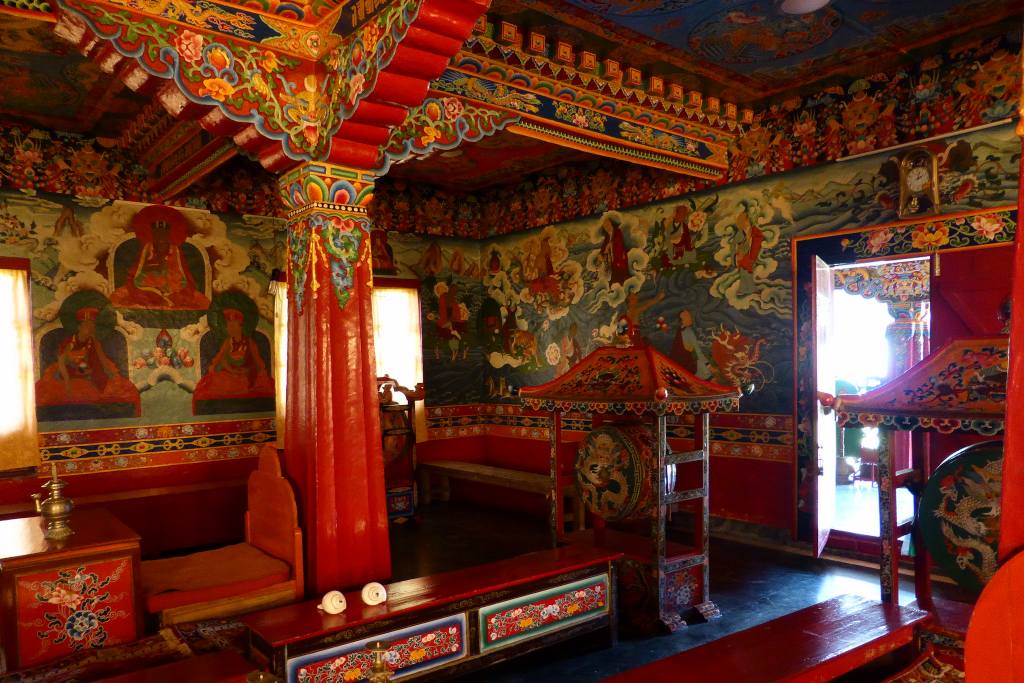
At a glance –
- Best Time to Visit: May to June during the celebration of Tibetan New Year
- Main Attraction: Its fine architecture. It resembles the original monastery in Tsurphu, Tibet.
- Also known for: World renowned centre for Kargu Teachings
- How to get there: It’s 24 km from Gangtok. Hire a local driver to take you there. From the gate to the monastery, there is an uphill walk.
- Built in: 1960s
Sikkim has a lot more to offer than its beautiful MG Marg which is where all tourists flock to. Check out the Rumtek Monastery situated at an elevation of 4,900 ft.
History
It was originally built in the mid 1700s under the guidance of Changchub Dorje, 12th Karmapa Lama. Rumtek was the main place of the Karma Kagyu lineage in Sikkim for some time. In 1959, Rangjung Rigpe Dorje, 16th Karmapa, came to Sikkim after fleeing Tibet.
At this point in time, the monastery was in ruins and he decided to rebuild it. 4 years later, the construction was finally completed. Sacred items and relics were brought from Tsurphu Monastery and were installed in Rumtek.
3. Tawang Monastery, Arunachal Pradesh

At a glance –
- Best Time to Visit: October to April
- Main Attraction: The architecture, the library and the view from the monastery
- How to get there: 80-km From Bomdila, Tawang District
- Built in: 1680 as per the wish of the 5th Dalai Lama
Arunachal Pradesh may very well be the Switzerland of India given its climate and beautiful landscapes. The Tawang Monastery is the largest monastery in India (situated at 10,000 feet) and the second largest in the world. In Tibetan, it is known as Golden Namgey Lhatse which roughly translates to celestial paradise in a clear night.
History
In 1680-1681, Tawang monastery was founded by Merak Lama Lodre Gyatso as per the wishes of the 5th Dalai Lama. The monastery belongs to Gelug school of Mahayana Buddhism and was religiously associated with Drepung Monastery of Lhasa.
There are 3 very interesting legends surrounding the establishment of the monastery. The first legend goes thus –
The location of the monastery is said to have been chosen by a horse that belonged to Merag Lama Lodre Gyatso. He was on a mission assigned to him by the 5th Dalai Lama to establish a monastery. He failed to find a suitable place and retired into a cave. When he came out, his horse was missing. He found his horse grazing at the top of the hill which is where the monastery now stands.
The second legend has to do with the name of the monastery. Tawang is associated with Terton Permalinga, diviner of treasures.
The third legend also has a horse at its center. Allegedly, a white horse of the Prince of Lhasa went missing and was found grazing where the monastery is currently located.
4. Namdroling Monastery, Coorg, Karnataka
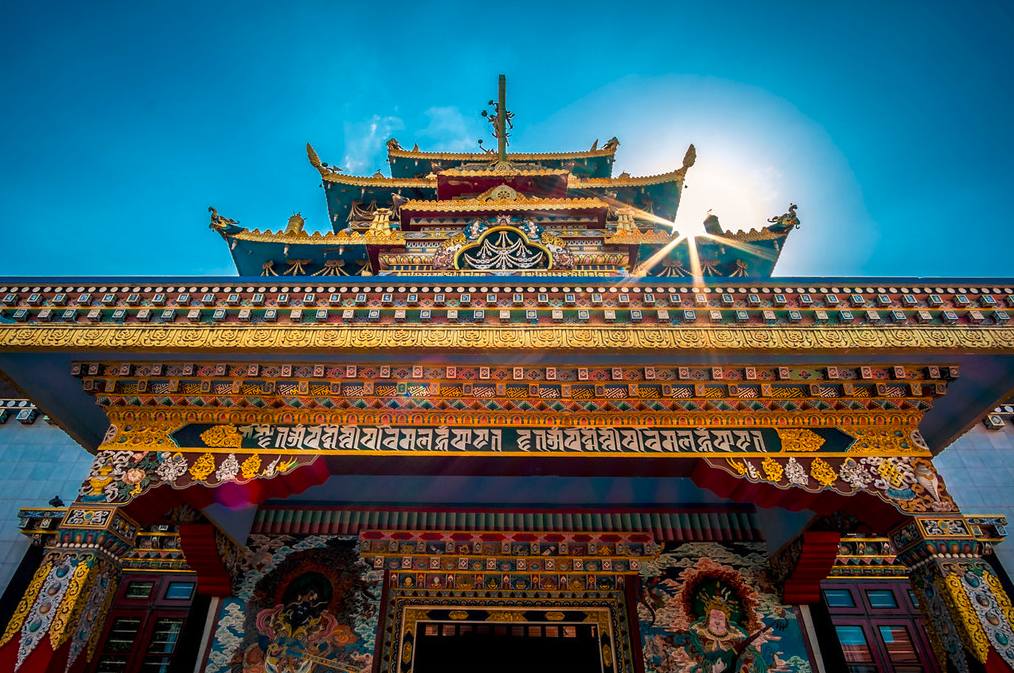
At a glance –
- Best time to visit: February to March
- Known as: The Golden Temple
- Built in: 1963
- How to get there: 8.2 km from the Kaveri Nisargadhama
- Note: A visit must be arranged by placing a call to the office.
South India isn’t just famous for its food, culture and Ayurveda; it has a monastery as well. Located in the sandal groves between Mysore and Bangalore, this monastery was consecrated by the Dalai Lama and named Namdroling Monastery. This monastery is the largest teaching center of the school of Tibetan Buddhism.
History
The 11th throne holder of the Palyul lineage is deemed to have established the monastery in 1963. His Holiness Drubwang Padma Norbu Rinpochein exited Tibet in 1959 post which the monastery in India was built.
The full name of the monastery is a bit of tongue twister – Thegchog Namdrol Shedrub Dargyeling, called “Namdrolling or Namdroling” for short. The initial structure was just a temple made from bamboo which covered an approximate area of 80 square feet.
5. Thiksey Monastery, Ladakh, Jammu and Kashmir

At a glance –
- Main Attraction: Fairy-tale town like appearance, 49 feet tall statue of Maitreya Buddha
- Also known for: Its similarity with the Potala Palace of Lhasa.
- Best Time to Visit: October to November
- Open: 7 am to 7 pm, all days of the week
- How to get there: Travel to Leh Airport and hire a cab or take the bus.
- Built in: Sometime in 15th century AD
- Note: There is a Rs 20/- entry fee for both locals and foreigners.
- Dining in: Dinner is served at 6:30 pm. Join the monks and stand in line to receive Thukpa. You could also get butter tea there. You are expected to wash your dishes.
If you visit Ladakh without making a trip to the Thiksey Monastery, you are seriously missing out something. This monastery is situated at an altitude of 11,800 feet and 20 km from Ladakh.
History
Je Tsongkhapa who was the founder of the Gelug School sent 6 of his disciples to spread the word of the new school in remote regions of Tibet. The Gelug School is often referred to as the ‘Yellow Hats’. One of the disciples was given a small statue of Amitayus that contained bone powder and a drop of Tsongkhapa’s blood. The disciple was directed to meet the King of Ladakh to seek his help in promoting Buddhism.
6. Hemis Monastery, Ladakh, Jammu and Kashmir

At a glance –
- Main Attraction: Beautiful architecture, large statues of Lord Buddha and Guru Rimpoche
- Best time to visit: June to July during the Hemis festival
- How to get there: 45 km from the Leh City. Hire a cab or a bullet/bike to take you there.
- Built in: Sometime before the 11th century. Re-established in 1672.
- Note: Photography is prohibited inside the museum of the monastery.
Another beautiful monastery in Ladakh that you should not miss. This is considered to be the largest monastery in the region.
History
This monastery existed before the 11th century. The yogi Tilopa had a pupil named Naropa who is associated with this monastery. Naropa’s biography was found in the monastery which was since been translated by A. Grünwedel.
7. Phugtal Monastery, Zanskar, Jammu and Kashmir
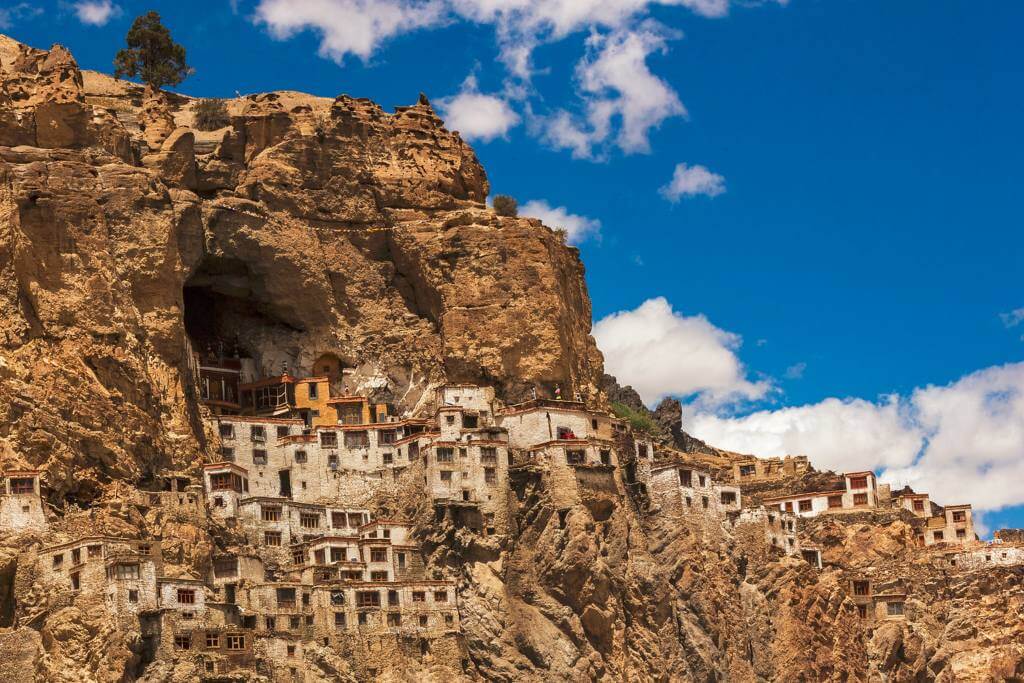
At a glance –
- Main Attraction: Beautiful landscapes
- How to get there: Suspension bridge to the monastery. It can be reached by foot.
- Built in: 12th century AD but remained undiscovered till 1826-27 to the outer world due to its extreme location.
The name, Phugtal / Phuktal, comes from the fact that this monastery was built on the mouth of cave. In the local language ‘Phuktal’ translates to ‘through the caves’. If you are an ardent trekker, you will love this monastery.
History
This monastery surrounds a natural cave which has apparently been visited by numerous people including sages, translators, monks and scholars around 2550 years ago. This theory may be true as the monastery is ideal for monks in search for peace and tranquility. The present day Gompa belongs to the Gelug School which was established in the 15th century. Jangsem Sherap Zangpo is credited as the person behind the establishment and he happens to be a disciple of Je Tsongkhapa.
8. Tabo Monastery, Spiti Valley, Himachal Pradesh
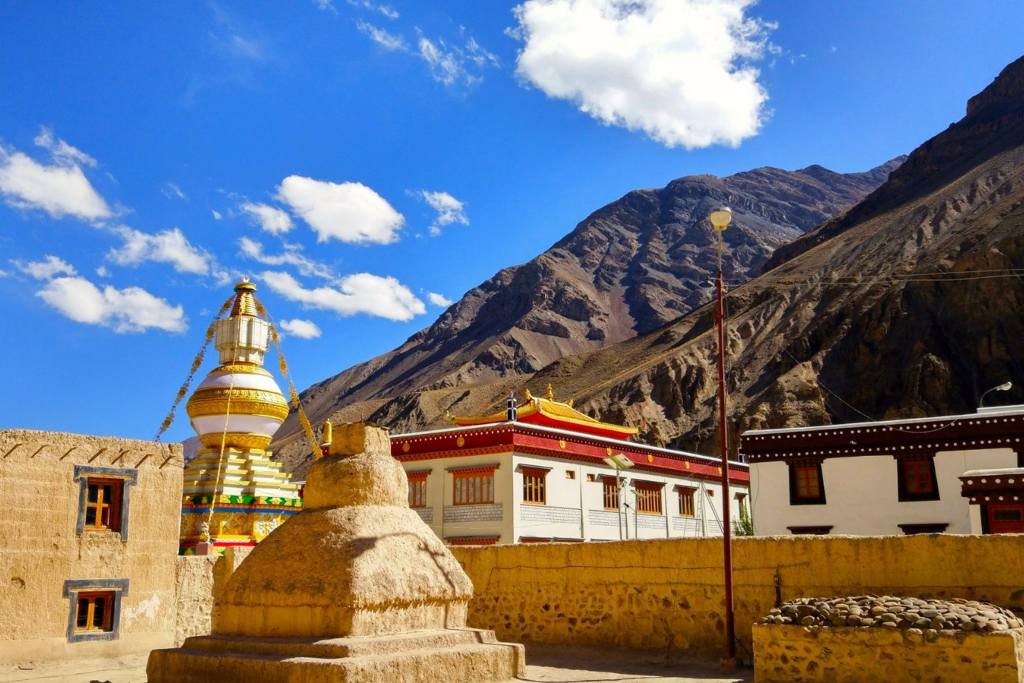
At a glance –
- Main Attraction: Meditation Caves dug in the mountain by hand
- Also known for: Paintings on walls and ceilings
- How to get there: By road. Check the road conditions before embarking on your journey
- Best Time to Visit: May to October. Rohtang Pass closed due to snowfall in October
- Built in: 990 AD
- Note: They support the Serkong School and need support and donations to keep it running.
Situated at an elevation of 10,000 feet ( approx.), Tabo Monastery is considered to be the oldest monastery in the country.
History
The 1975 Kinnaur earthquake left the original monastery in great ruins. It was fully restored and new structures were added post which the 14th Dalai Lama visited the monastery. He also initiated the Kalachakra Festival in 1983. He revisited the monastery in 1996 and returned on several different occasions.
9. Mindrolling Monastery, Dehradun, Uttrakhand
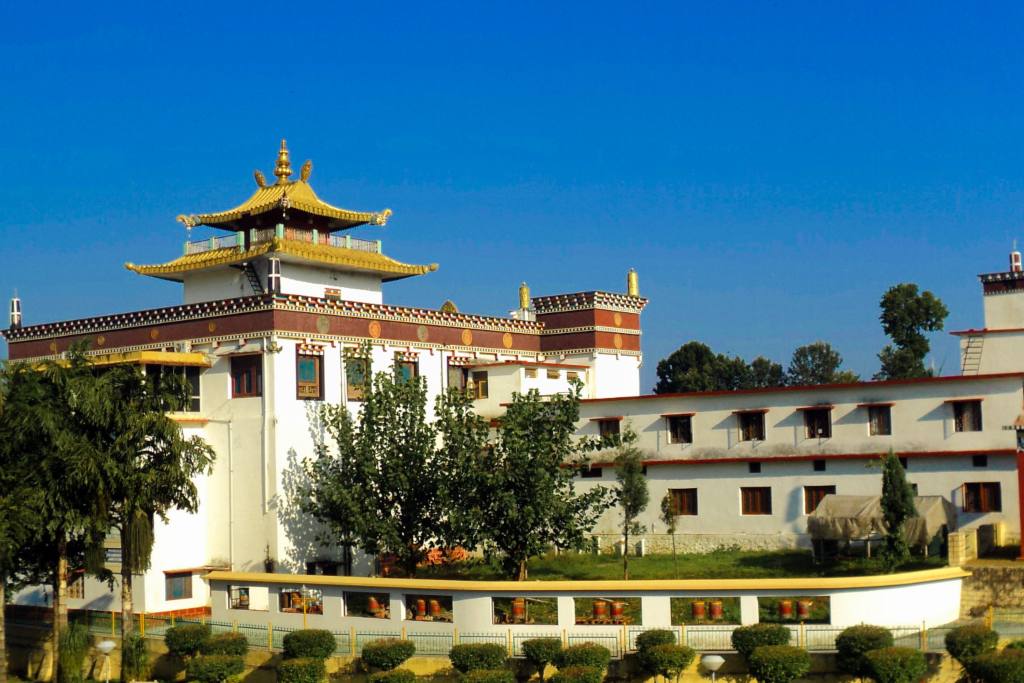
At a glance –
- Main Attraction: 185 feet tall and 100 feet wide Great Stupa which is the largest stupa in the world.
- Also known for: Ngagyur Nyingma College, one of the largest Buddhist institutes
- How to get there: 10 kms from Dehradun
- Built in: 1876
Dehradun isn’t just a stop gap to Rishikesh or Varanasi. The beautiful Mindrolling Monastery is a proof of that. The name means ‘Place of Perfect Emancipation’.
History
Khochhen Rinpoche and a group of monks began the establishment process of re-establishing the Mindrolling Monastery in 1965. This was located in Clement Town and it now contains Ngagyur Nyingma College which is one of the largest Buddhist institutes in India.
10. Gondola Monastery, Himachal Pradesh
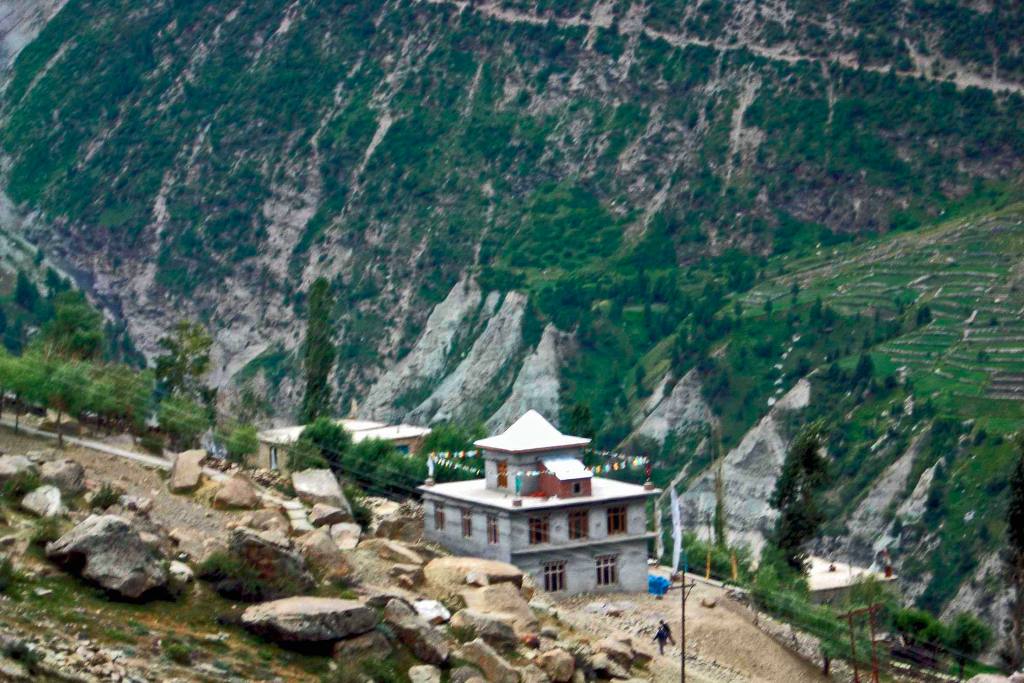
At a glance –
- How to get there: By road, its 18 kms before Keylong in Lahaul and Spiti district, Himachal Pradesh, India on the road from Manali.
- Main Attraction: 7 storey tall monastery with alternative storeys of bricks and timber. Huge wooden statues of Guru Rinpoche.
- Built in: 8th century AD at an altitude of 10,370 ft in Himachal, this monastery dates back to the 8th Century AD.
This is one monastery that you should not miss in Himachal. Situated at an altitude of 10,370 feet at the sacred junction of Chandra and Bhaga rivers.
History
Padmasambhava founded the Gondola monastery in the 8th century. The Drukpa Lineage is associated with this monastery now. However, the history of the monastery goes further back than the Kagyu School ( Drukpa Lineage).
11. Kye Monastery, Spiti Valley, Himachal Pradesh

At a glance –
- How to get there: 10 hours by road from Manali or Shimla. From Kaza, you can take a bus.
- Best Time to Visit: June to July during their festival
- Built in: 11th century AD
At an elevation of 13,668 feet, the Kye Monastery is adorned with beautiful murals and paintings, thangkas, prayer bells and unique wind instruments.
History
Dromton is credited as the founder of the Kye Gompa Monastery. He was the pupil of the famous teacher, Atisha in the 11th century.
12. Tashi Jong Monastery, Palampur, Himachal Pradesh
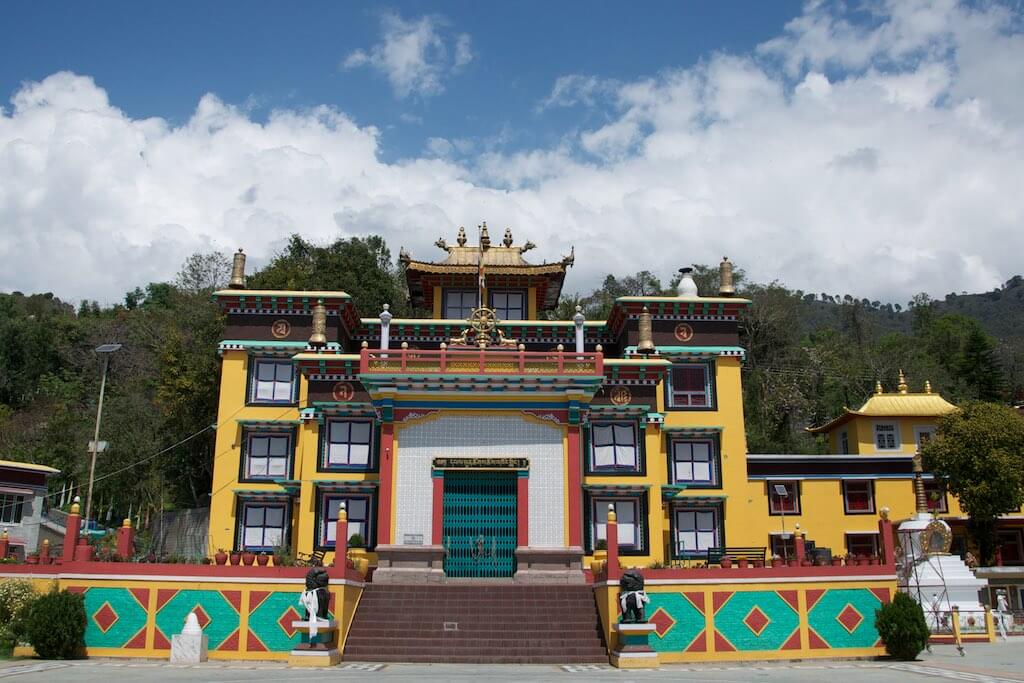
At a glance –
- How to get there: It’s about 15 kms from Palampur.
- Built in: 1950
This picturesque destination should definitely be on your list. The Tashi Jong Monastery is also an excellent craft emporium from where you can buy some souvenirs to immortalise your trip. The name Tashi Jong means auspicious valley in Tibetan.
History
The monastery was founded by the 8th Khamtrul Rinpoche, Dongyu Nyima. The community practices ascetic yoga. Tilopa, the tantric yogi of India developed a meditation technique called Mahamudra. Tibetans developed another technique called ‘Kadmapa’ and the combination of the two culminated in the Drugpa Kagyu School.
13. Enchey Monastery, Gangtok, Sikkim
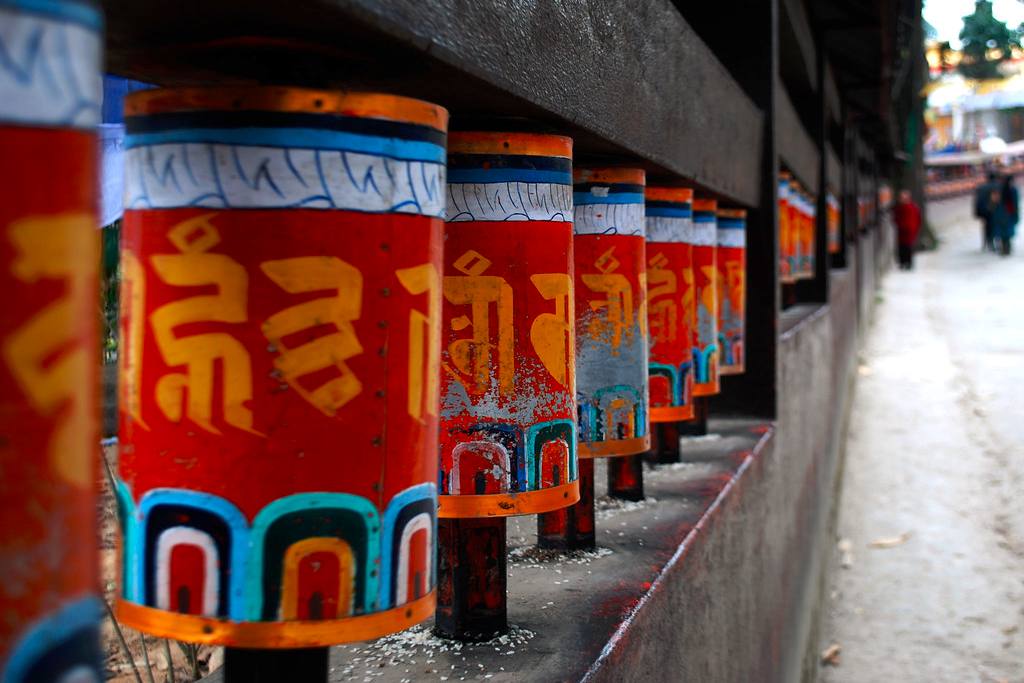
At a glance –
- Best time to visit: June to October, during the ‘Chaam’ festival
- Built in: 1890
Gangtok is home to another beautiful monastery called Enchey Monastery. ‘Echey’ means solitary temple.
History
The Enchey Monastery belongs to the Nyingma order of Vajrayana Buddhism. The monastery quickly became a religious place in the small city of Gangtok. The monastery is said to have been blessed by Lama Drupthob Karpo. He was a well-known expert of tantric art in Buddhism with flying powers.
14. Tsuglagkhang Complex, Dharamshala

At a glance –
- Also known for: The museum, Namgyal Gompa, Kalachakra temple and many more sacred paintings of the Buddhist culture.
- Open: to everyone and no restrictions are imposed on visiting any part of the monastery except Dalai Lama’s residence.
- Note: You can also choose to go on an evening walk with the monks.
The official residence of the Dalai Lama, this complex is situated near Mcleodganj.
The complex counts among one of the most significant places of worship that draws a lot of attention from national as well as international tourists and devotees.
15. Diskit Monastery, Leh

At a glance –
- Built in: 14th century
- Main Attraction: Beautiful architecture and the large statue of the Jampa Buddha.
- Best Time to visit: February during the ‘Festival of Scapegoat’
The oldest and largest monastery in Leh, the Diskit Monastery is also known as Diskit Gompa.
History
This monastery also belongs to the Gelugpa also known as Yellow Hat sect of Tibetan Buddhism. Changzem Tserab Zangpo is credited as the founder of the monastery. He was a disciple of Tsongkhapa who was the founder of Gelugpa. The monastery is a sub-gompa of the Thiksey gompa.
16. Gonjang Monastery, Sikkim
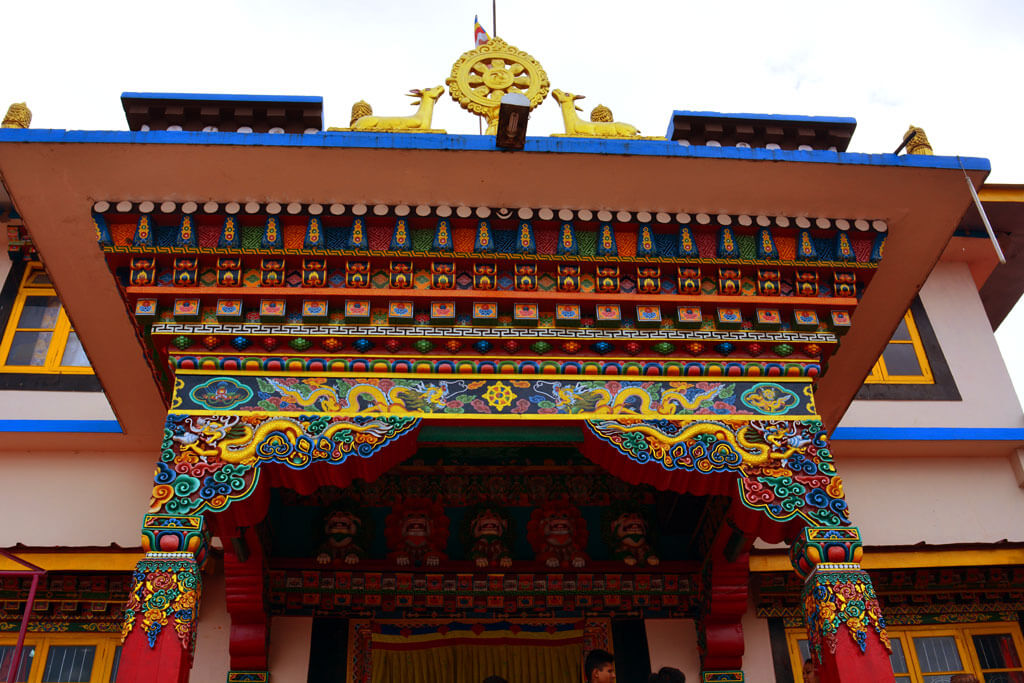
At a glance –
- Built in: 1981
- Best Time to Visit: December to January, during the ‘Nyingma International Peace Aspiration Prayer’.
Another beautiful monastery in Sikkim, Gonjang Monastery is set against an extremely serene background.
History
In the year 1981, H.E. Tingkye Gonjang Rimpoche founded the monastery. Yelmo Terton Ngakchang Shakya Zangpo’s reincarnation is said to be the founder of the monastery. The monastery follows Nyingma school of Tibetan Buddhism.
17. Palpung Sherabling Monastic Seat, Kangra Valley, Himachal Pradesh

At a glance –
- How to get there: From Dharamsala to the Palpung Sherabling Monastic Seat, it is a journey of two and half hours.
- Main Attraction: Ancient Buddhist culture
- Note: A separate guest house is provided for tourists.
One of the few Buddhist monasteries that has snow-capped mountains as the backdrop, the Palpung Sherabling Monastic Seat is a must-see monastery.
History
In 1975, a protected pine forested land became the foundation of the monastic seat. This land was donated by the present 12th Kenting Tai Situpa disciples. The disciples hailed from Derge and Nangchen region and had settled in Bir, Himachal Pradesh. It was designed by Kenting Tai Situpa. The materials used are modern and the architecture reeks of Tibetan architectural fashion. It follows the ancient science of geomancy.
18. The Lamayuru Monastery
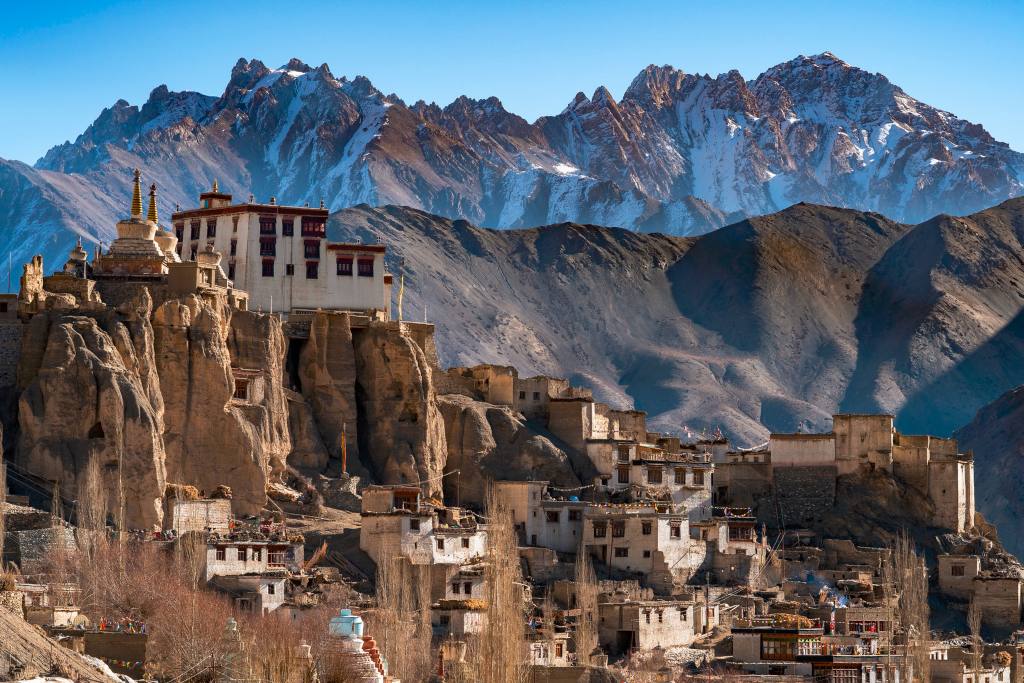
At a glance –
- Major Attraction: Tall prayer flag pole, Dukh Gang, murals and Naropa’s cave.
- How to get there: It is situated on the Srinagar-Leh highway 15 kilometres east of the Fotu La.
- Note: There is a small hotel adjoining its boundaries where you can stay.
If you love peace and serenity, Lamayuru will leave you astonished and enchanted. This monastery is isolated and you can enjoy complete silence here. Its situated at 11520 feet.
History
The first Bon Monastery in Ladakh, the name translates to sauwastika. The monastery’s name is associated with the popular symbol in Bon that means eternity. It is associated with the Drikung Kagyu school of Buddhism. According to the Drikung history, Naropa is said to have caused a lake in a valley to dry up which laid the foundation of the monastery.
Buddhist terms that you should know before you go visit any of these monasteries:
- Gompas: In Tibetan Buddhism, Gompas mean monasteries
- Thukpa: A soup with vegetables and noodles in it
- Stupa: A dome shaped building built as a Buddhist shrine
- Vihara: A Buddhist monastery with residence for monks
- Chaitya: An assembly hall that contains a stupa
Sound off in the comments below if you’ve visited these monasteries and tell us about your experience!

